
All categories
Featured selections
Trade Assurance
Buyer Central
Help Center
Get the app
Become a supplier

(13176 products available)

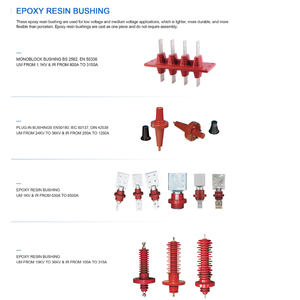


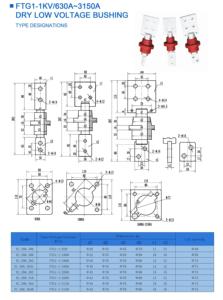

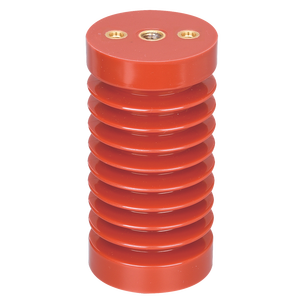

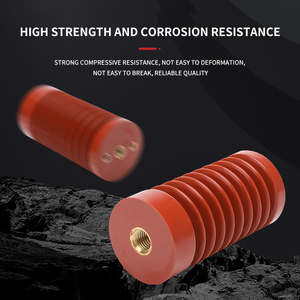






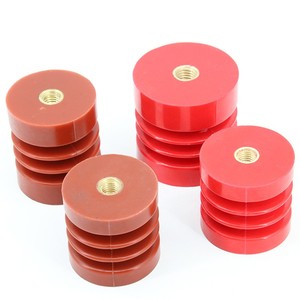





















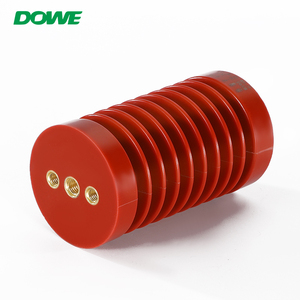



Epoxy resins are usually preferred for their excellent thermal stability and electrical insulating properties. High-voltage epoxy resin insulators are designed to withstand extreme electrical stress environments, such as power transmission equipment and electrical machinery. They are critical in providing insulation and mechanical strength while protecting the device from moisture and environmental degradation.
Here are some common types of high voltage epoxy resin casting insulators:
Standard High Voltage Epoxy Resin
This type of epoxy is designed to deliver excellent electrical insulating properties and chemical resistance. Standard high-voltage epoxy resins are commonly used in power generation, electrical machinery, and outdoor equipment. The epoxy's ability to withstand high voltages and environmental factors makes it ideal for high-stress applications.
Filled Epoxy Resins
Filled epoxies contain additives and fillers such as glass fibers that enhance the materials' mechanical properties. The fillers help improve the resin's thermal conductivity, reduce shrinkage during curing, and enhance its resistance to electrical tracking (the formation of conductive paths across the surface of the insulator). Filled epoxy resins are ideal for high-voltage insulation applications requiring additional mechanical strength and heat dissipation, such as motor stators, transformer coils, or high-voltage capacitors.
Thermal Conductive Epoxy Resins
These are specially designed to offer superior heat dissipation, thus preventing overheating in high-voltage electrical systems. These epoxies typically have high electrical insulation resistance and are favored in electronic and electrical applications where heat build-up poses a risk to the integrity of insulating components. These may include power semiconductor devices, electrical resistors, or circuit boards in high-voltage environments.
Atmospheric-Curing Epoxy Resins
Also known as moisture-cured, these epoxy resins cure and form a strong, moisture-resistant bond in humid or wet conditions. This quality makes them ideal for outdoor or marine electrical systems exposed to harsh weather elements. High-voltage atmospheric-curing epoxies offer excellent adhesive and insulating properties and withstand humidity and temperature variations.
Low-Viscosity Epoxy Resins
Low-viscosity epoxy resins are formulated to have a much lower viscosity, allowing them to penetrate and fill small gaps and voids effectively. This property makes them ideal for high-voltage applications that require excellent insulation and minimal air entrainment (which causes insulation breakdown) within a system. These resins are used to encapsulate wires, components, and circuitry in potting and casting applications.
Heat-Curing Epoxy Resins
Heat-curing epoxies are engineered to achieve maximum performance through a heat application process during the curing stage. In high-voltage applications, where insulation needs to withstand extreme temperature and electrical stress conditions, these resins provide exceptionally strong bonds and greater resistance to electrical breakdown. Power generators, electronic devices, and other machinery in high-voltage environments commonly employ heat-curing epoxies.
Hybrid Epoxy Resin Systems
These comprise combinations of epoxy resin types or blends with other polymer materials to achieve a balance of thermal resistance, electrical insulation, and mechanical strength properties. In high-voltage applications, such as electric vehicles, renewable energy systems, and high-performance industrial equipment, hybrid epoxy resin systems are used. These are normally designed to meet specific insulation and sealing requirements over extended periods.
The primary function of a high-voltage epoxy resin casting insulator is to provide superior electrical insulation and mechanical support to components operating under extreme electrical stress. It protects electrical systems from environmental factors like moisture and temperature, effectively preventing electrical failures like short circuits.
The design of high-voltage epoxy resin casting insulators strongly emphasizes creating materials with specific chemical and physical properties that optimize performance in challenging electrical environments.
High-voltage epoxy resin insulators employ a two-component system consisting of a resin and a hardener that, when mixed, cross-link to form a dense three-dimensional polymer network. This is also called thermosetting epoxy resin. The network's tightly packed molecular structure gives the cured epoxy a high level of rigidity and dielectric strength.
Charge carriers cannot easily migrate through these structures; hence, the electric current is contained within the component boundary, insulating a valuable electro-electronic asset.
In high-voltage environments, the insulator must also be able to withstand elevated temperatures while routinely displaying its excellent dielectric strength.
Chemically, fillers and additives like silica, alumina, and other thermally stable materials are incorporated into the epoxy formulation to aid achieving these goals. Some fillers enhance thermal conductivity and mechanical strength. Others are specifically selected to increase the epoxies' resistance to electrical tracking (formation of undesirable conductive surfaces) and physical degradation. These may include chemical additives such as anti-tracking agents and UV stabilizers, which protect the insulator from environmental hazards. Tracking can lead to catastrophic failure by creating conductive paths on the surface of the insulator.
The design may also include reinforcement, such as glass fibers, to boost the resin's mechanical properties, delivering toughness and rigidity. Such filler's primary purpose is to hold the insulator's form and much-needed dielectric strength, especially in heat-filled high-voltage environments.
The combination of carefully selected resin chemistries, fillers, additives, and reinforcement provides high-voltage epoxy resin casting insulators with the required performance characteristics needed for reliability in extreme service conditions.
Power Generation and Distribution
High-voltage epoxy resin insulators are predominantly used in the power generation and distribution industry to encapsulate and insulate high-voltage electrical apparatus such as transformers, generators, and circuit breakers. They enjoy exceptional dielectric strength, thermal stability, and chemical resistance, protecting these components against arcing, overheating, and environmental factors (moisture, dirt) that can cause electrical failures. In power transmission systems like substations and power lines, epoxy cast resin insulators safeguard the wires and hardware against electrical surges and adverse weather conditions.
Industrial Electric Motors and Machinery
The high-voltage epoxy resin insulator is vital in virtually all industrial machinery, including large electric motors, compressors, and pumps. They encase motor windings and other high-voltage components to insulate them and prevent arcing in the dynamically rotating motor. Epoxy resins also improve mechanical strength, thus securing and supporting components in place. In heavy machinery used in mining, manufacturing, and other industrial fields, these insulators protect electrical systems from extreme operating conditions, ensuring reliability and longevity.
Aerospace and Defense Equipment
High-voltage epoxy resin insulators are lightweight and strong, thus find application in aerospace and defense electrical equipment like radar systems, communication devices, and navigation gear. They deliver electrical insulation and mechanical support. Their high dielectric strength and resistance to extreme vibrations, temperatures, and other environmental stress factors (like radiation) ensure reliability and performance in critical applications like satellites and aircraft.
Renewable Energy Systems
High-voltage epoxy resin insulators are typically used in renewable energy systems such as solar inverters and wind power generators to provide crucial insulation for high-voltage electrical components in renewable energy systems like solar panels, wind turbine generators, and battery storage systems, which are equipped with high-voltage epoxy resin insulator castings. Their durability, environmental resistance, and exceptional insulating properties ensure the long-term reliability of these systems even under adverse weather conditions. As renewable energy systems must withstand high voltage levels and different outdoor elements, insulation like cast resins is critical to maintain system safety and efficiency.
Transportation Systems
High-voltage epoxy resin insulators are commonly employed in electrical and electronic systems for mass transit systems like trains and subways. Cast resins insulate and protect high-voltage components in signalling systems, electrified tracks, and transportation control systems against arcing, moisture, and physical vibrations. They help keep systems operational and void transportation delays and safety hazards.
High-Voltage Testing Equipment
Some high-voltage epoxy resin insulators are used to insulate components in high-voltage testing equipment, such as test chambers and voltage application devices. These insulators ensure safety, prevent the system from shorting out, and guarantee accuracy during the testing of electrical/electronic devices for industrial and commercial applications.
Electrical Insulating Properties
The primary function of a high-voltage epoxy resin casting insulator is to provide superb electrical insulation. Operating voltage level: The resin must have good dielectric strength to withstand the working voltage level of the equipment. The dielectric constant should also be high. This allows the material to store electrical energy in order to improve its insulating ability and prevent electrical energy from migrating through the material to cause faults like arcing and short circuits.
Mechanical Strength and Adhesion
High-voltage epoxy resin casting insulator must have sufficient mechanical strength to bear electrical machine stress and unusual environmental conditions like shocks, vibrations, humidity, and temperature changes. It also has to possess good adhesion (ability to bond) to different surfaces so that it will secure electrical components in place and prevent their movement. This is essential to maintain the equipment's optimal functionality.
Thermal Properties
The operating temperature range of the epoxy resin must be compatible with the environment it will reside in and the expected heat levels generated by electrical currents within themselves. The epoxy should have an adequate glass transition temperature range. This is the temperature range over which the material will not become soft and hence loses its mechanical and electrical insulating strength. Epoxy resins often include thermal fillers to augment this property. The resin should also possess good thermal conductivity to dissipate generated heat.
Chemical and Environmental Resistance
In outdoor electrical applications, high-voltage epoxy resin casting insulators may come into contact with chemicals, moisture, and extreme weather conditions. For example, UV exposure may result in outdoor exposure to chemical attacks like pollution and water, with resins containing low tear resistance and anti-tracking additives. The weathering and chemical resistance of the resin can be improved by incorporating stabilizers and block copolymer-based additives.
Curing Characteristics
High-voltage epoxy resin casting insulators are frequently two-part systems that require mixing and curing to give them the desired mechanical/electrical properties. The curing time must be sufficient for the application, but it should also be short enough to prevent workability loss during installation. The curing temperature must be compatible with the substrate to which the insulator will bond. The pot life of the mixture must be long enough to allow for proper application yet short enough to prevent it from curing prematurely before the end of the installation process.
A.
Exceptional Dielectric Strength
This refers to the material's ability to bear high voltages without breaking down. High dielectric strength levels mean better insulation performance, so the electric current can't migrate through the epoxy to cause faults like arcing and short circuits.
Thermal Stability
The glass transition temperature is at the back of the mind of every electric engineer because any increase in temperature above this range will not only cause the material to become soft but also lose its electrical insulating ability. Over time, generated heat in a high-voltage apparatus may degrade the resin. High-temperature stability levels allow the resin to remain operational under high-heat conditions without losing strength.
Chemical and Environmental Resistance
High-voltage epoxy resin insulation is often used in outdoor environments and industrial areas exposed to chemicals, weather elements, and extreme environmental conditions. UV radiation, chemical attack, and moisture may cause the resin to break down. Additives and stabilizers are used to improve chemical and environmental exposure resistance to ensure longevity.
Low Viscosity and Good Workability
After mixing of the two components of the epoxy resin, it must have sufficient flow so that it can easily fill gaps within the casting and eliminate air entrainment. This property enables proper application. The pot life must be long enough to allow for proper installation, but it can't be so long that it allows the mixture to cure before the end of the installation.
Mechanical Strength and Adhesion
High mechanical strength is required to maintain the resin even under shock, vibration, and physical stress. Bonding (adhesion) to various surfaces is equally important to ensure electrical components remain stable and insulated so that performance isn't jeopardized. With proper mechanical strength and adhesive characteristics, the resin will not crack or peel apart from its surface even under extreme conditions.
A.
Increased Reliability
Subsequent to encapsulating high-voltage components in the resin, electrical systems operate without short circuits and arcing, increasing reliability and ensuring stability for system operation even after prolonged exposure to high voltage.
Improved Durability
These resins have superb resistance to chemicals and weather elements like UV radiation. Thus, they improve long-term durability in electric gear and protection against external threats, leading to a longer life span for the equipment.
Enhanced Performance
By dissipating heat better and maintaining thermal stability, high-voltage epoxy resins ensure that equipment performs optimally without overheating, helping in delivery of reliable performance even in high-demand scenarios.
Versatility
They are popular in the electric power industry, defence, transportation, and renewable energy fields due to their ability to meet varying insulation demands across different industrial applications.
Sealing and Moisture Protection
They not only insulate but also seal gaps and voids to prevent moisture infiltration and humidity, which are the main culprits for electrical failures and short circuits.
A.
Temperature
Operating temperature affects the epoxies. The range may be enormously vast, from several sub-zero degrees to over a hundred degrees. Whichever the case, thermoset epoxies for cast resin insulators must perform without compromising their ease of work. It means they should not fallough the heat may get softer or the cold freezing them to hard resin.
Mechanical Stress
Electrical equipment generally vibrates, shocks, or experiences physical stress during normal operation. High voltage may cause these to snap or break, and the resin does not have the strength to support these.
Chemical Exposure
Electrical equipment, especially those outdoors or in industrial settings, may become victim to a number of chemical exposures, including pollutants in the air, industrial cleaning agents, and those used during ordinary maintenance.
Moisture and Humidity
Insulation tends to suffer most from moisture infiltration and high humidity, especially when the water vapor condenses inside the electrical equipment. Combined with other elements, this leads to tracking and arcing across surfaces.
UV Exposure
Many epoxy resin insulators are exposed to continuous sunlight, which causes UV rays to degrade the material over time, leading to breakdown of its electrical insulating properties.
A. The high-voltage epoxy resin insulator feature is its exceptional dielectric strength, which makes it capable of enduring high voltages without electrical breakdown. This is supported by thermal stability, where the resin does not soften or lose its structural integrity as it operates within a broad temperature range. It is also chemically resistant. Therefore, it is applicable in many outdoor and industrial environments. Moreover, the material enjoys lower viscosity during mixture preparation, thus permitting it to flow, fill voids, and eliminate air entrainment without becoming prematurely set..
A. High-voltage epoxy resin insulators are best popular in the electrical power industry, be it installations or equipment, such as generators, transformers, motors, circuit breakers, electrical control gear, etc. They are also used in aerospace, automotive, telecommunications, industrial machinery, field testing and measurement apparatus, electric trains, and space.